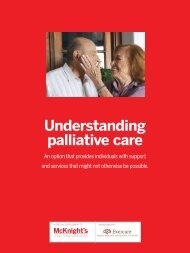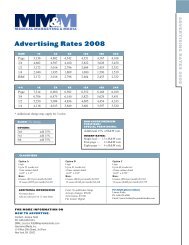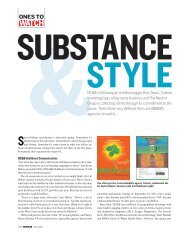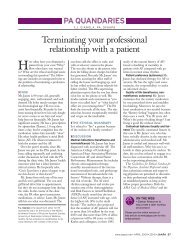Review - Haymarket Media Group
Review - Haymarket Media Group
Review - Haymarket Media Group
Create successful ePaper yourself
Turn your PDF publications into a flip-book with our unique Google optimized e-Paper software.
<strong>Review</strong><br />
and to test for significant differences in the times<br />
to events. A post hoc analysis of outcomes according<br />
to hormone receptor status and HER2 status<br />
was performed.<br />
Study Results<br />
Between October 1999 and January 2002, 5052<br />
patients were enrolled, of whom 4950 were eligible.<br />
The benefit of weekly paclitaxel was<br />
seen in patients with HER2-negative<br />
disease irrespective of their<br />
hormone receptor status.<br />
There were no significant differences among the<br />
patient groups. The median age was 51 years, and<br />
the majority of patients were hormone receptor positive<br />
(69.5%) and HER2 negative (67.5%). Most<br />
patients (97%) received all four cycles of doxorubicin<br />
and cyclophosphamide. The proportions of patients<br />
who received all taxane doses were 95% (paclitaxel<br />
Table 1<br />
5-Year Disease-Free Survival and Overall Survival in Four Treatment Arms<br />
12 The American Journal of Hematology/Oncology<br />
every 3 weeks), 88% (paclitaxel weekly), 87% (docetaxel<br />
every 3 weeks), and 75% (docetaxel weekly).<br />
The proportions of patients who required dose modification<br />
of the taxane were 22%, 29%, 28%, and 40%,<br />
respectively.<br />
At a median follow-up of 63.8 months, 1048<br />
patients had a recurrence of breast cancer or cancer<br />
in the contralateral breast, and 686 had died. The<br />
estimated 5-year disease-free survival rates were<br />
76.9% for the patients receiving every-3-week paclitaxel,<br />
81.5% for patients receiving weekly paclitaxel,<br />
81.2% for patients receiving every-3-week docetaxel,<br />
and 77.6% for patients receiving weekly docetaxel<br />
(Table 1). The study met its end point and demonstrated<br />
a significant improvement in disease-free survival<br />
in the group receiving weekly paclitaxel and in<br />
the group receiving docetaxel every 3 weeks (Table<br />
2). Weekly paclitaxel compared with standard therapy<br />
was associated with an improved overall survival<br />
(hazard ratio, 1.32, P=0.01) that was not seen in the<br />
patients receiving weekly docetaxel or every-3-week<br />
docetaxel (Table 3).<br />
Recent data have suggested that patients with<br />
hormone receptor–positive and HER2-negative<br />
breast cancer may not derive a benefit from adjuvant<br />
taxane therapy. 7 Therefore, the investigators analyzed<br />
the effect of hormone receptor status and<br />
HER2 expression on the efficacy of weekly paclitaxel<br />
Treatment Arm 5-Year Disease-Free Survival 5-Year Overall Survival<br />
Every-3-week paclitaxel 76.9% 86.5%<br />
Weekly paclitaxel 81.5% 89.7%<br />
Every-3-week docetaxel 81.2% 87.3%<br />
Weekly docetaxel 77.6% 86.2%<br />
Table 2<br />
Hazard Ratio for Disease-Free Survival in the Experimental Treatment Arms Compared With<br />
Standard Every-3-Week Paclitaxel<br />
Treatment Arm Hazard Ratio 95% CI P Value<br />
Weekly paclitaxel 1.27 1.03-1.57 0.006<br />
Every-3-week docetaxel 1.23 1.00-1.52 0.02<br />
Weekly docetaxel 1.09 0.89-1.34 0.29
















